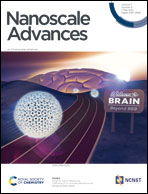Upconversion-based nanosystems for fluorescence sensing of pH and H2O2†
Abstract
Hydrogen peroxide (H2O2), a key reactive oxygen species, plays an important role in living organisms, industrial and environmental fields. Here, a non-contact upconversion nanosystem based on the excitation energy attenuation (EEA) effect and a conventional upconversion nanosystem based on the joint effect of EEA and fluorescence resonance energy transfer (FRET) are designed for the fluorescence sensing of H2O2. We show that the upconversion luminescence (UCL) is quenched by MoO3−x nanosheets (NSs) in both systems due to the strong absorbance of MoO3−x NSs in the visible and near-infrared regions. The recovery in UCL emissions upon addition of H2O2 enables quantitative monitoring of H2O2. Benefiting from the non-contact method, hydrophobic OA-NaYF4:Yb,Er can be used as the luminophore directly and ultrahigh quenching efficiency (99.8%) is obtained. Moreover, the non-contact method exhibits high sensitivity toward H2O2 with a detection limit of 0.63 μM, which is lower than that determined by simple spectrophotometry (0.75 μM) and conventional upconversion-based nanocomposites (9.61 μM). As an added benefit, the same strategy can be applied to the sensing of pH, showing a broad pH-responsive property over a range of 2.6 to 8.2. The successful preparation of different upconversion-based nanosystems for H2O2 sensing using the same material as the quencher provides a new design strategy for fluorescence sensing of other analytes.



 Please wait while we load your content...
Please wait while we load your content...